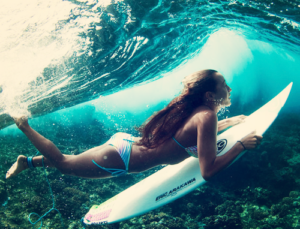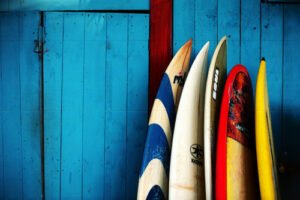Ever wanted to learn how to surf? Here is a beginner’s guide to get you started. This blog post will include a list of items you will need… as well as some tips and tricks to get you surfing quicker than you think. Don’t be discouraged if it takes you longer than your friends or even longer than you think it should. Practice makes perfect! If you don’t live near the sea and can only test your skills during the holidays, keep these useful tips in mind when you decide to hit the waves during your vacation.
What you need:
- Surfboard: There are a number of factors that contribute to your first surfboard purchase; these include: how often you plan to use it, your budget and your body type. Generally speaking, soft boards are ideal for beginners. They are large in volume, which makes them more stable when you try to balance and stand. However, the downside of soft boards is that you will quickly outgrow them. If you decide to surf on a regular basis, consider purchasing a hand-shaped board like a longboard. Remember: the bigger, the better.
- Wetsuit: If you are planning on investing a lot of time and effort into surfing, then take the time to buy yourself a quality wetsuit, especially if the waters you are venturing into are cold (if you lucky and they are warmer, board shorts can also do the trick). There are different types of wetsuits. You get short suits (wetsuits that have short legs and arms) as well as long wetsuits. They also come in different thicknesses; naturally, the thicker the suit is, the warmer it is for the surfer. Choosing the right size and fit is the crucial part of the purchasing process. You don’t want to buy a wetsuit that is so tight that you are unable to move. You also do not want it to be too loose, because that would allow the suit to move too far away from your body. The function of a wetsuit is to trap a thin layer of water between the wetsuit and the surfer’s skin. A “warm blanket” effect is created when the surfer’s body temperature heats this thin layer of water. Clever, don’t you think? If you are delving into cold waters often. you need to ensure that your wetsuit has a tight-fitting neck piece to avoid cold water from entering your suit.
- Surfboard leash: This is also known as a leg rope. The function? To attach your leg to your surfboard, ensuring you are never separated from it. This tiny piece of equipment is a must… which is why you should ensure you purchase a high quality leash that won’t break. Here is why you need a surfboard leash: you are preventing your board from getting washed up on the beach or even worse, getting damaged by rocks, etc. It also allows you to increase your recovery time and saves you a swim every time you need to go find and fetch your surfboard.
- Surf wax: This is exactly what the name suggests, wax. The purpose is to stop you from slipping and sliding off the surfboard when paddling, standing or surfing on it. Apply the surf wax before you hit the waves, on the spot where your feet will be positioned as well as the on the rails where your hands grip onto the surfboard.
Tips and tricks
Let’s be honest..surfing is not easy, but that doesn’t mean you can’t do it. Almost anyone can surf, you just need to want to. Once you get all your surfing gear (mentioned above), you can use the tips and tricks below to get you started. After that, all you need is a little bit of tenacity and patience.
- If you know someone who surfs, take them with you to buy your surfboard, wetsuit and extras. Ask them to take you out on the waves for a few hours while you get the hang of it. Get as many tips as you can from experienced surfers!
- Practice on the ground first. You need to start with your belly flat on the surfboard. Practice your paddling motion and getting up on your surfboard.
- Now practice in the water! Make sure you find the right position on your surfboard. You are too far forward if your face is touching the water. You are too far back if your neck is strained and your nose too far up. For the perfect position, your nose needs to be a few centimeters away from the water. Make sure your feet are out of the water and placed together. Lastly, you will need to arch your back so that your weight lies at the bottom of your rib cage.
- Now paddle! Extend your arms in front of you, cup your hands with your fingers a little apart, and propel your arms to push your board. Paddle for the waves that have already broken. Alternatively, you can stand in the water until it reaches your stomach, then jump onto the board (on your belly) as soon as the wave comes in. Tip! Using the correct paddling technique is a big part of becoming a good surfer.
 How to duck dive? The secret to duck diving successfully is timing. This is something you will only improve on with time and naturally a lot of practicing. Here are a few tips. As you approach the wave, paddle swiftly towards it to build up some speed. Hold onto your surfboard as tight as possible and push the board down into the water with your chest as deep as you can (the deeper the better). Then submerge your body into the water with your board. As the wave is just about to pass over you, use your leg or knee to push down on the back of your board so that it can go as far underwater as possible. When the wave passes over you, pull up the front of your board to allow yourself to come to the surface.
How to duck dive? The secret to duck diving successfully is timing. This is something you will only improve on with time and naturally a lot of practicing. Here are a few tips. As you approach the wave, paddle swiftly towards it to build up some speed. Hold onto your surfboard as tight as possible and push the board down into the water with your chest as deep as you can (the deeper the better). Then submerge your body into the water with your board. As the wave is just about to pass over you, use your leg or knee to push down on the back of your board so that it can go as far underwater as possible. When the wave passes over you, pull up the front of your board to allow yourself to come to the surface.
- Now for the most important question: how to catch your first wave? Once you have paddled past the breakers, you will notice a line of surfers waiting in anticipation for the perfect wave. This is called the lineup zone, takeoff zone or peak. Tip! Beware not to paddle all the way into a group of experienced surfers and be conscious of surfer etiquette. Where to sit in the lineup? If you have a long board you can position yourself more on the outside; however if you have a shortboard, make sure you are more on the inside.
- When to catch the wave? This part is based on experience or rather trial and error. Unless you have an experienced surfer to tell you when to go for it…you will have to learn the hard way. When you see the right wave you need to use your legs to turn the board around so that you face the beach and have your back to the wave. Quickly get into a paddling position and paddle swiftly towards the shore, looking back to examine the position of the wave and determine whether you should paddle faster or slower.
- You will know that the wave has reached you once the back of your board starts to lift. If you think the wave has caught you, then it is time to pop up and ride the wave!
- How to stand? Stand on the board with your feet apart, knees bent and your hands out for balance. When standing on your surfboard, resist the temptation to get on your knees first, try to stand on the board in one swift motion. Tip! Ride the wave straight to the shore until you start to get the hang of it. Once you feel more experienced, you can start angling your board so that you can ride the face of the wave.
Now you have all the tips you need to catch your first wave, have fun!












